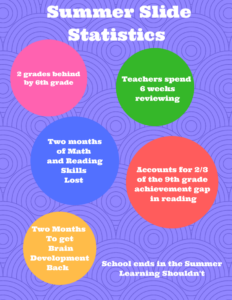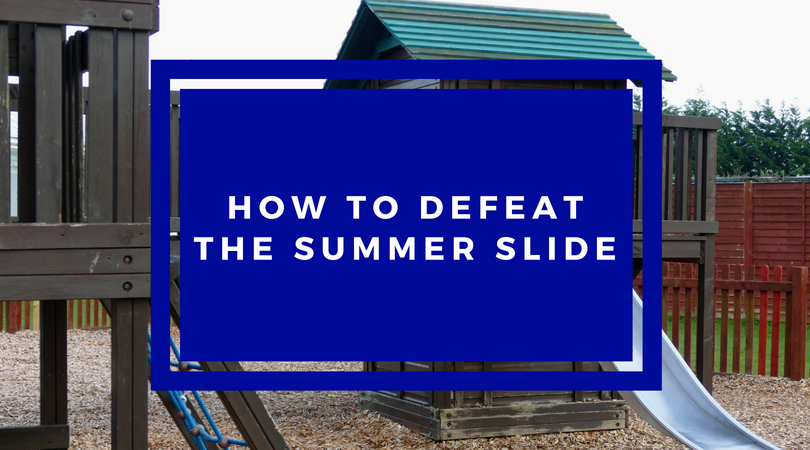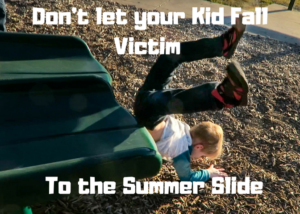How to Defeat The Summer Slide
I think that most people can agree that summer is often an exciting time for students and for families. Kids are excited that they don’t have to go to and from school every day. You may also be excited about family vacations and the opportunity to participate in camps or other programs that only the bright rays of summer will allow to take place. I remember growing up and taking beach trips with my family during the summer. I looked forward to being able to stay out and play with my friends in the neighborhood as the days got longer and the street lights didn’t come on till later.
However, you may also be worried wondering what your kids are going to do this summer, how to entertain them for the hours that they are home that they didn’t use to be, and possibly how to get them ahead for the next school year.
For some of you who work you are putting your students in camps and hoping that they have fun but also learn something there. It can feel majorly overwhelming to come up with activities to keep your children entertained or to supplement their camp learning. You also are trying to make sure that they will not lose all the information that they have spent all school year learning. All of it may seem overwhelming. You may have heard of the summer slide, but think that it is not that important or that it happens to all students.
In this blog post, I will explain exactly what the summer slide is and why it’s important. I will continue this conversation in future blog posts to give you easy helpful tips for helping your child be as prepared as possible for the next grade level.
Why the Summer Slide is Something that You Should be Concerned About
What exactly is the summer slide? This is usually what happens to students who do not focus on anything school related during in the summer. It affects mostly the students that come from lower income levels. Whereas students from higher income levels usually make slight gains.
The reason behind this is quite simple. Higher income students normally have some form of learning that they are doing over the summer. Lower-income students don’t. If we don’t practice something we will get rusty at it.
Therefore, students ability to perform grade level tasks goes down significantly from the end of the school year to the beginning of the next school year. The summer slide is the reason why the first couple months of school are usually spent reviewing the topics from the last grade before moving on to new material.
So, it may seem okay to have the summer slide. The teacher will review this material anyway, so it doesn’t matter if my child is performing at a lower level, as the other students will probably be as well.
The problem with this type of thinking is that the further that students slide, the harder it is for them to get back on track. Also, not all students are sliding so if your child is they will be behind. Other students who maintain grade level knowledge and expand their learning over the summer are the ones that do significantly better in the fall when school starts again.

Want to Read More?
Stop the “Reading is Boring” Excuse
5 Math Games to Make Learning Fun
How to Have Educational Vacations in Los Angeles
Students Who Slide During the Summer are Two years Behind by Grade Six
You read that right. Students that have significant learning loss during the summer are as much as two years behind their peers when they start middle school. This puts them at a disadvantage that only gets greater as they near high school. Studies show that Summer learning loss accounts for ⅔ of the 9th-grade achievement gap in reading.
Likewise, on a smaller scale, some students lose 2.6 months of math skills and two months of reading skills over the summer. This loss can be seen in students as young as the 1st grade. Teachers then have to spend an average of six weeks reviewing material that these students had already mastered and knew just a few short months before.
Students brain development also takes up to two months to get back on track after summer vacation. This takes away time from new material and explains why students end up so far behind by the time they reach the 6th grade. There is a solution. There are some things that you can do to make sure that your students do not experience the summer slide.
2-3 Hours Per Week is All it Takes
Two to three hours a week of learning-based activities is all that it takes for students to not fall victim to the summer slide. This keeps their brain development on track. Then they don’t have to spend two months when school starts again getting back on track. This is also incredibly doable.
Two hours a week is only 20 minutes a day of learning activities. It doesn’t mean that you now have to become the person that is forcing your students to do tons of school work when they just want to go outside and enjoy the summer. It makes it so learning can still be fun.
Also, it will be easier for them both now and in the long run because they haven’t lost their learning yet. It is easy to incorporate small bouts of learning to make sure that your child will not fall behind in school. Remember success begins early.
Also, as was shown in the data above, the summer slide disproportionately affects students of lower income. Preventing summer learning loss does not have to cost any money. It will cost a bit of time, but it does not have to cost money. Stay tuned for future posts where I will be listing free resources that parents can take advantage of now to make sure their students succeed as much as possible for the coming school year.
If you enjoyed this post please share it so that others can benefit as well. A great way to share is through Pinterest.



Very true. 2-3 hours per week is all it takes for the kid to get ahead in class. And yes lots of kids do work in the summer. And they love it 🙂